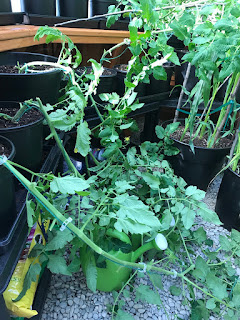
We've been looking for trees to use as a wind break, and to help cover some of the hilly parts of our yard that I'd rather not have to mow in future years. We have some beautiful Norway Spruce on base where I work in Anchorage, so we decided to get some Norway Spruce for the yard.
Not easy to find in Alaska, though, and any big ones are either in high demand or hard to get, so we found a company that would ship some live seedlings to us.
Two sizes, 10 of the larger seedlings, and 21 of the smaller size. More than we needed, but we decided to plant them closer together than normal, and thin them out in future years once they get bigger.
Gives you some idea how small the seedlings are...30 trees in one bucket, and each of these can grow to over 100 feet tall (but that will take a long, long time).
Placed along the front side of the property, these trees will eventually grow together.

And down the side towards our little orchard, these we planted closer and will thin them out earlier than the front yard.

A happy little tree.
This section of our yard stays a little dry, and is fairly rocky underneath. Norway Spruce are supposed to be hardy in all types of soil, and resistant to spruce beetle attacks, so we're hoping they thrive here.
Planted one on the steep hill near our front porch....hopefully it will get big enough to cover over this portion of the lawn since it is very difficult to mow.
I've now planted 50 trees on the property this year, including these 31 Norway Spruce, 4 fruit trees, 10 Black Spruce from a good friend, and 5 spruce transplanted from one side of the property to the other. We also planted 6 blueberry bushes, and a raspberry bush given to us by our great neighbors. Of all those plantings, so far we've only lost 1 little spruce transplant, and have another larger spruce transplant that is fighting but not looking too good. If we lose it, I'll transplant one more to replace it, and then I'm done digging holes!
I've now planted 50 trees on the property this year, including these 31 Norway Spruce, 4 fruit trees, 10 Black Spruce from a good friend, and 5 spruce transplanted from one side of the property to the other. We also planted 6 blueberry bushes, and a raspberry bush given to us by our great neighbors. Of all those plantings, so far we've only lost 1 little spruce transplant, and have another larger spruce transplant that is fighting but not looking too good. If we lose it, I'll transplant one more to replace it, and then I'm done digging holes!
A dahlia, which Jolene set at the door to the greenhouse, to entice some pollinators in.
Thinning out the carrots, lettuce and onions.
And some beets also needed thinning out.
Salsa pepper.
Pumpkin bloom. This is one of the male blooms. We are pollinating the greenhouse plants by hand, and take care to get the pumpkins, squash and cucumbers pollinated anytime we have a male and female bloom open at the same time. The tomatoes and peppers are easier, as they only have one type of bloom.





















































